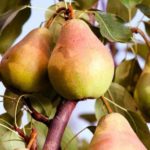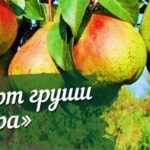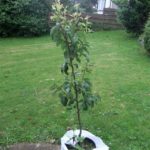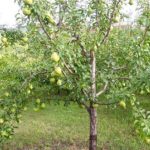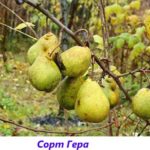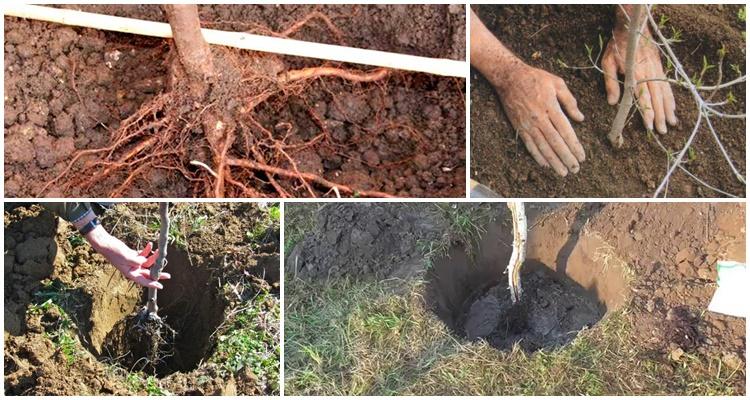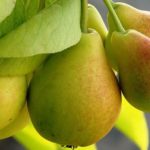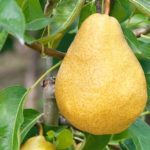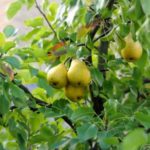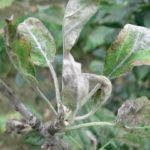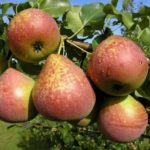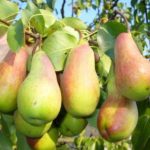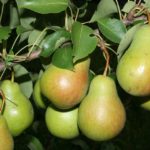When choosing seedlings for their summer cottage or garden plot, all people expect to receive good harvests of tasty, aromatic fruits. In addition, the trees must be suitable for a particular region and not suffer from harsh winters or prolonged heat. Today’s detailed story is about the benefits that the owner receives when he plants the Hera pear in his garden.
- Description and characteristics of the pear variety Hera
- Main advantages and disadvantages
- How to grow crops correctly
- Recommended timing
- Site selection and soil preparation
- Selection and preparation of seedlings
- Landing algorithm
- Further care
- Watering
- Fertilizer
- Trimming
- Methods of protection against diseases and pests
- Collection and storage of Hera pear
Description and characteristics of the pear variety Hera
This is a high-yielding winter pear variety that is frost-resistant. The result of the work of Russian breeders. Hera's ancestors were two varieties of pears - Daughter of the Dawn and Reale Turin. The variety was bred in 2003 and recommended for cultivation in the Central Black Earth region. Hera's taste is rated 4.3 on a 5-point scale.
A tree of medium height (about 4 meters), the dense compact crown has a pyramidal shape. The trunk and branches are straight, the leaves are medium in size, dark green in color with a shiny smooth surface. The fruits are regular in shape, large, from 180-230 grams, with juicy, sweet and sour, slightly grainy pulp. Pears are green with a yellowish-pink side. The core is small. Rough, dry skin of medium thickness. The fruits can be stored for 3-3.5 months after collection. It is during storage that they “develop” their taste and reveal their best qualities.
Main advantages and disadvantages
The variety was bred for the central regions of Russia, Siberia and the Urals. It turned out to be early-bearing (begins to bear fruit 4 years after planting), unpretentious in care and productive, so it has become very popular among gardeners in areas with a temperate climate.
The tree can tolerate frosts below -30 °C. This made it possible to grow southern crops in regions with a fairly harsh climate. The fruits last a long time, they can be eaten fresh, they are suitable for compotes, preserves, jams, and other types of processing.
Hera is a self-fertile variety, but to maintain productivity it is planted nearby late varieties of pears or plant winter species of Hera: Artemovskaya winter, Dekabrinka, Uralochka.
How to grow crops correctly
Hera pear is an unpretentious variety created for growing in your personal garden plot. Hera is not used for industrial cultivation; the fruits lose their presentation during transportation.
Recommended timing
It is better to plant Hera in the fall, in September, although spring planting is also possible. Seedlings are characterized by excellent survival rate. If a pear is planted in the spring, this is done in May; when planting in the fall, the seedling should have time to adapt and take root in a new place before the onset of cold weather.
Site selection and soil preparation
For planting, choose sunny, dry, wind-protected areas. Pear does not tolerate waterlogged soil. It is not suitable for heavy soil, acidic or saline soil. Acidic soils are limed before planting. Do not plant pears in lowlands. Hera easily tolerates cold, so it can grow on a sunny hill without suffering from the wind.
The width and depth of the planting hole is 70-80 centimeters. It is prepared 7-10 days before planting. A drainage layer of broken bricks and gravel is laid at the bottom.
Selection and preparation of seedlings
1-2 year old seedlings are selected for planting. They must be strong, without visible damage to the trunk and roots. Options with dry twigs or roots are rejected. Before planting, the roots of the plant are treated with a preparation against fungi and bacteria and a growth stimulator.
Landing algorithm
The optimal mixture for pears is a 1:1 mixture of sand and humus with the addition of superphosphate and potassium sulfate. A mound of soil is placed at the bottom of the pit. A peg is dug in at a distance of 20-25 centimeters from the center of the hole. The seedling is placed on the top of an earthen mound and the roots are carefully straightened.
Fill the hole with the remaining soil mixture, compact the soil, eliminating voids. The seedling is tied to a peg. The planting is watered along the edge of the hole. The root collar should be above the surface of the planting hole.
A day after planting, the seedling is pruned, leaving about 50 centimeters in height. This is done to form a lush crown. The tree trunk circle is mulched to retain moisture.
Further care
If the tree has taken root well, the first fruits can be expected 4 years after planting. After 6 years, the tree begins to produce stable high yields.
Watering
A root groove is made for watering. The young tree is watered 2 times a month. During flowering and during the formation of the ovary, watering is increased.
Fertilizer
In the spring, nitrogen fertilizer is applied, before flowering and during fruit formation - magnesium sulfate. Once every 2-3 years, in mid-summer, phosphorus fertilizers are added to the soil.
Trimming
Gera’s crown does not need to be molded; sanitary pruning is enough for her. In spring, frozen branches are removed. When pruning in autumn, dry branches are removed.
Methods of protection against diseases and pests
In early spring, preventive spraying of pears is carried out. Use “Hom”, “Chorus” or “Skor” in strict accordance with the manufacturer’s recommendations. These drugs protect against scab, powdery mildew, fire blight and other diseases.
Branches affected by infection are pruned and burned. The tree is treated with insecticides against insect pests.
Collection and storage of Hera pear
The variety is winter, the harvest is harvested after the 1st decade of September. The fruits are placed in layers in boxes, the bottom of which is covered with paper, sawdust or sand. If there are only a few pears, each one is packed in paper for better storage.
The fruits in the box should lie freely, the rows of pears are laid out with paper, they should not come into contact with each other during storage. In this form, the fruits are stored for 3-3.5 months. This variety has already won the love of gardeners for its unpretentiousness and productivity, allowing residents of the middle zone and more northern regions to feast on delicious juicy fruits.


